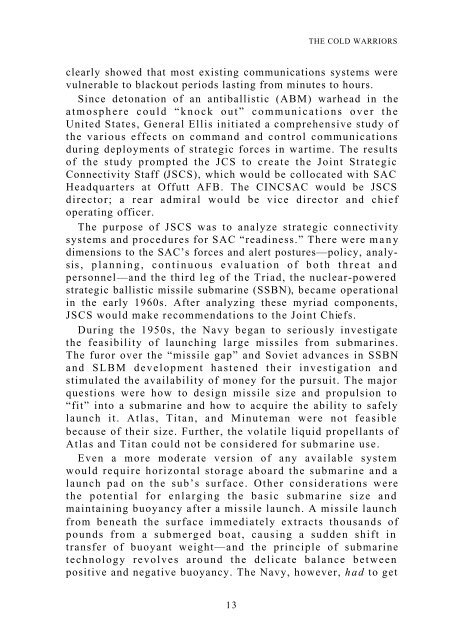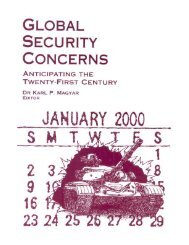Inside the Cold War - Project Gutenberg Consortia Center
Inside the Cold War - Project Gutenberg Consortia Center
Inside the Cold War - Project Gutenberg Consortia Center
You also want an ePaper? Increase the reach of your titles
YUMPU automatically turns print PDFs into web optimized ePapers that Google loves.
THE COLD WARRIORS<br />
clearly showed that most existing communications systems were<br />
vulnerable to blackout periods lasting from minutes to hours.<br />
Since detonation of an antiballistic (ABM) warhead in <strong>the</strong><br />
atmosphere could “knock out” communications over <strong>the</strong><br />
United States, General Ellis initiated a comprehensive study of<br />
<strong>the</strong> various effects on command and control communications<br />
during deployments of strategic forces in wartime. The results<br />
of <strong>the</strong> study prompted <strong>the</strong> JCS to create <strong>the</strong> Joint Strategic<br />
Connectivity Staff (JSCS), which would be collocated with SAC<br />
Headquarters at Offutt AFB. The CINCSAC would be JSCS<br />
director; a rear admiral would be vice director and chief<br />
operating officer.<br />
The purpose of JSCS was to analyze strategic connectivity<br />
systems and procedures for SAC “readiness.” There were many<br />
dimensions to <strong>the</strong> SAC’s forces and alert postures—policy, analysis,<br />
planning, continuous evaluation of both threat and<br />
personnel—and <strong>the</strong> third leg of <strong>the</strong> Triad, <strong>the</strong> nuclear-powered<br />
strategic ballistic missile submarine (SSBN), became operational<br />
in <strong>the</strong> early 1960s. After analyzing <strong>the</strong>se myriad components,<br />
JSCS would make recommendations to <strong>the</strong> Joint Chiefs.<br />
During <strong>the</strong> 1950s, <strong>the</strong> Navy began to seriously investigate<br />
<strong>the</strong> feasibility of launching large missiles from submarines.<br />
The furor over <strong>the</strong> “missile gap” and Soviet advances in SSBN<br />
and SLBM development hastened <strong>the</strong>ir investigation and<br />
stimulated <strong>the</strong> availability of money for <strong>the</strong> pursuit. The major<br />
questions were how to design missile size and propulsion to<br />
“fit” into a submarine and how to acquire <strong>the</strong> ability to safely<br />
launch it. Atlas, Titan, and Minuteman were not feasible<br />
because of <strong>the</strong>ir size. Fur<strong>the</strong>r, <strong>the</strong> volatile liquid propellants of<br />
Atlas and Titan could not be considered for submarine use.<br />
Even a more moderate version of any available system<br />
would require horizontal storage aboard <strong>the</strong> submarine and a<br />
launch pad on <strong>the</strong> sub’s surface. O<strong>the</strong>r considerations were<br />
<strong>the</strong> potential for enlarging <strong>the</strong> basic submarine size and<br />
maintaining buoyancy after a missile launch. A missile launch<br />
from beneath <strong>the</strong> surface immediately extracts thousands of<br />
pounds from a submerged boat, causing a sudden shift in<br />
transfer of buoyant weight—and <strong>the</strong> principle of submarine<br />
technology revolves around <strong>the</strong> delicate balance between<br />
positive and negative buoyancy. The Navy, however, had to get<br />
13






